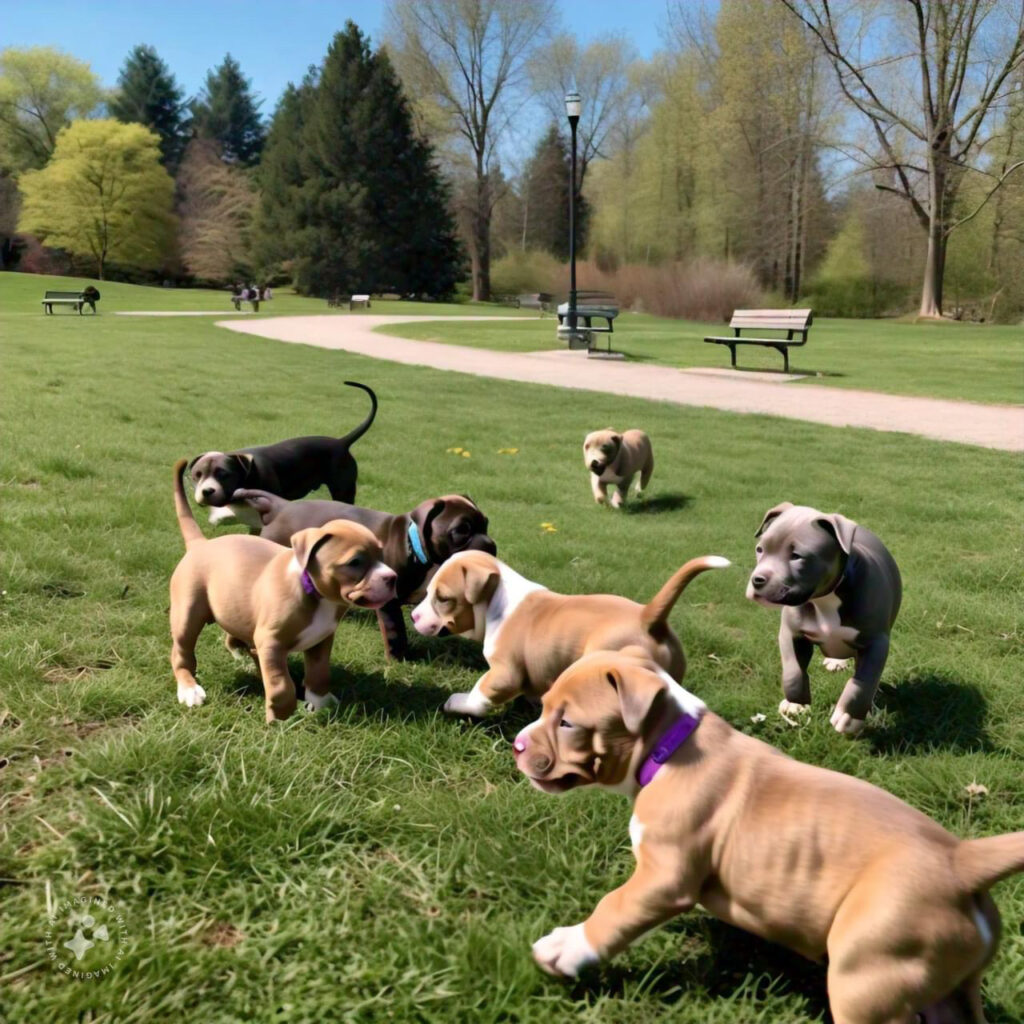Did you know that some pit bulls simply will not get along with other dogs? It’s important to understand how to introduce pitbull puppies to other puppies and pitbull puppies alike.
When introducing your Pit Bull to another dog, it’s best to do it in a neutral area. This reduces the chance of territorial behavior.
Make sure both dogs are on leashes and wear collars that fit well. Avoid using chokes or prong collars, as they can be harmful if a fight happens.
This blog will give you key guidelines for a smooth and safe ways to introduce your puppy bit bull to others.

Why Proper Puppy Introduction Matters
Introducing a new pit bull puppy to other dogs is key for a peaceful home. It helps stop fights and keeps everyone safe.
Start in a neutral area to reduce territorial behavior, keeping both dogs on leashes with well-fitted collars. Walk them together to get used to each other, and watch for any signs of stress, or aggression.
If things get tense, try again later or seek help from a trainer. Patience is key—let the dogs set the pace and use treats and praise for positive reinforcement.
With the right approach, your Pit Bull can become a well-adjusted and happy member of the family.
How To Introduce Pitbull Puppies
Bringing a new pitbull puppy home is exciting but needs care. It’s important whether you’re adding a new puppy to a home with other dogs or meeting other pets. The goal is to make a safe and positive space for both dogs to get used to each other.
A great way to introduce pitbull puppies is through a controlled walk. Take both dogs for a walk in a neutral place like a park or quiet street, keeping them on leashes. This helps prevent territorial issues and lets the dogs meet slowly without stress.
- Begin by walking the dogs side-by-side, keeping a safe distance. Keep a calm and positive vibe, giving treats and praise for good behavior.
- As they get more comfortable, you can bring them closer, letting them sniff and interact a bit while you watch closely.
- If a dog shows aggression or discomfort, like growling or trying to get away, separate them right away and stop the introduction.
- Keep doing the controlled walk in different places over several times. This helps the dogs get used to each other and build a positive connection.
Make sure to use the right collars and strong leashes during introductions. Avoid choke or prong collars as they can make things worse. Also, keep the leashes loose to prevent the dogs from feeling trapped or anxious.
Introducing pitbull puppies may take a few tries and shouldn’t be rushed. Taking your time helps prevent fights and helps your dogs live together peacefully.
Preventing Territorial Behavior and Aggression
When introducing your Pit Bull puppy to other dogs, it’s important to do it slowly and carefully to prevent territorial behavior and aggression. Start in a neutral place like a park to avoid territorial instincts.
Keep both dogs on leashes and have two people handle them for better control. Walk them together to reduce tension, and use treats to reward calm behavior. Watch for signs of stress or aggression, and separate them if needed.
Be patient and let the dogs set the pace. If issues persist, consider seeking help from a professional trainer. With a thoughtful approach, your dogs can learn to get along peacefully.
Ensuring Safety for Both Dogs and Owners
Keeping everyone safe is the main goal. Watch the dogs closely, stop fights early, and have places for them to rest. This makes introducing them a success.
If things don’t go well at first, slow down and try again. Getting help from a certified trainer is a good idea if fights keep happening.
Learning how to properly introduce pit bull puppies helps make a safe, happy home for all dogs.
The Controlled Walk Introduction Method
Introducing a pit bull puppy to another dog can be done with the controlled walk method. The controlled walk method is a careful way to help pit bull puppies and other dogs meet safely. By following these steps and paying attention to their body language, you can help them become friends.
Start by walking the dogs in a neutral area, keeping them on leashes and apart. As they get used to each other, let them sniff each other’s midsection in a “T-shape” formation. Always watch for signs of aggression like stiff postures, growling, or lunging.
If you see any aggressive behavior, stop the introduction right away and do the following:
- Start with a neutral area walk to reduce territorial instincts.
- Allow the dogs to sniff each other’s midsection in a “T-shape” formation, not face-to-face.
- Watch for signs of aggression, including stiff posture, growling, lip curling, and lunging.
- Interrupt the introduction immediately if any aggressive behaviors are observed.
- Maintain a slight U-shape in the leash to reduce tension during the walk.
- Gradually transition to off-leash interactions in a fenced area after successful on-leash walks.
- Avoid using choke chains or prong collars during the introduction process.
- Provide each dog with their own space, food, and toys to prevent potential conflicts.
- Be patient, as it may take multiple sessions over time for the dogs to become comfortable with each other.
- Celebrate positive interactions and enjoy the journey of building a lifelong friendship between the dogs.
This approach increases the chances of a successful meeting and a lasting friendship between the dogs.

Socializing Your Pitbull Puppy Early
Pitbull puppies need early socialization to become friendly and confident dogs. This process is key for their behavior and how they interact with others and their surroundings.
By exposing your puppy to positive experiences early on, you can stop fear-based aggression and encourage a love for learning and exploring.
Benefits of Early Socialization
Socializing your pitbull puppy has many benefits. It boosts their confidence, teaches them how to interact with others, and lowers the chance of fear or aggression later. Socialized puppies tend to become friendly, adaptable, and well-rounded adults.
- Builds confidence and reduces fear-based behaviors
- Teaches appropriate social skills and interactions with people and other animals
- Prevents the development of behavioral issues, such as fear or aggression
- Fosters a lifelong love of learning and exploration
- Produces friendly, adaptable, and well-rounded adult pitbull dogs
The best time to socialize pitbull puppies is between 4 and 14 weeks, especially from 8 to 12 weeks. This is when they learn a lot about the world and form their first impressions. It’s vital to give your puppy positive experiences during this time for their future development.
Socialization is important throughout your pitbull’s life, but the early months are crucial. By introducing your puppy to different people, animals, and environments in a positive way, you help them become adaptable and friendly.
Training and positive reinforcement are also key to shaping their behavior and creating a strong bond for years ahead.

Responsible Pitbull Ownership
Owning a pitbull puppy is rewarding but comes with big responsibilities. These dogs need special care and training to be good friends. It’s key to focus on their obedience training, exercise needs, and overall care.
Consistent obedience training is crucial for pit bulls. They do well with positive reinforcement to learn commands and behave right. Training helps strengthen your bond and makes sure they’re safe and well-behaved.
Pit bulls also need a lot of daily exercise to stay happy and healthy. Without enough activity, they might act out. So, walks, playtime, and toys are a must. Exercise keeps them fit and stops bad behaviors.
Getting your pitbull used to different people, animals, and places is also key. This helps them feel confident and lowers the chance of aggression. Early and regular socialization is vital for their happiness and safety.
Looking after a pitbull also means providing a secure environment, regular grooming, and teaching them to walk on a leash. With the right care, you and your pitbull can have a great bond. This helps show the true nature of this often misunderstood breed.
Being a responsible pitbull owner takes time, patience, and effort. But, the joy of having a loyal friend makes it all worth it. By focusing on your pitbull’s needs, you can change the way people see this amazing breed.
Conclusion
Introducing pitbull puppies to new places and other dogs needs patience and control. This ensures a smooth and safe start. Use the controlled walk method, early socialization, and lots of exercise and training. This helps your pitbull puppy succeed and builds a strong bond.
Pit bulls are often seen in a bad light because of the media. But with the right socialization and training, they become loving friends. Early positive experiences and training help your pitbull puppy grow into a well-adjusted dog. It’s important to know your dog’s needs and personality.
The secret to a good start with pitbull puppies is patience, consistency, and understanding their needs. By making introductions positive and controlled, your pitbull puppy will do well. This approach helps your puppy thrive and creates a strong bond with your family and community.



30 comments
Your point of view caught my eye and was very interesting. Thanks. I have a question for you.
Your point of view caught my eye and was very interesting. Thanks. I have a question for you. https://accounts.binance.com/register?ref=IJFGOAID
Your point of view caught my eye and was very interesting. Thanks. I have a question for you.
Can you be more specific about the content of your article? After reading it, I still have some doubts. Hope you can help me.
Your article helped me a lot, is there any more related content? Thanks!
Thank you for your sharing. I am worried that I lack creative ideas. It is your article that makes me full of hope. Thank you. But, I have a question, can you help me?
Thanks for sharing. I read many of your blog posts, cool, your blog is very good.
Your point of view caught my eye and was very interesting. Thanks. I have a question for you.
Your article helped me a lot, is there any more related content? Thanks!
I don’t think the title of your article matches the content lol. Just kidding, mainly because I had some doubts after reading the article.
I don’t think the title of your article matches the content lol. Just kidding, mainly because I had some doubts after reading the article.
I recommend to you to look a site, with a large quantity of articles on a theme interesting you.
Thanks for sharing. I read many of your blog posts, cool, your blog is very good.
Your enticle helped me a lot, is there any more related content? Thanks!
boat hire cuba
Thank you for your sharing. I am worried that I lack creative ideas. It is your article that makes me full of hope. Thank you. But, I have a question, can you help me?
https://auctionwheels.info/cars/lotus/pagination/start
https://t.me/s/Official_1win_kanal/1790
https://t.me/s/Webs_1WIN
Официальный Telegram канал 1win Casinо. Казинo и ставки от 1вин. Фриспины, актуальное зеркало официального сайта 1 win. Регистрируйся в ван вин, соверши вход в один вин, получай бонус используя промокод и начните играть на реальные деньги.
https://t.me/s/Official_1win_kanal/3251
купить виртуальный номер для приема смс
Thank you for your sharing. I am worried that I lack creative ideas. It is your article that makes me full of hope. Thank you. But, I have a question, can you help me? https://www.binance.com/join?ref=P9L9FQKY
Can you be more specific about the content of your article? After reading it, I still have some doubts. Hope you can help me. https://www.binance.info/ro/register?ref=V3MG69RO
I have read your article carefully and I agree with you very much. This has provided a great help for my thesis writing, and I will seriously improve it. However, I don’t know much about a certain place. Can you help me? найкращий реферальний код на бнанс
In my opinion you are mistaken. Write to me in PM.
Your point of view caught my eye and was very interesting. Thanks. I have a question for you. cuenta gratuita en Binance
Your point of view caught my eye and was very interesting. Thanks. I have a question for you.
Can you be more specific about the content of your article? After reading it, I still have some doubts. Hope you can help me.
Thanks for sharing. I read many of your blog posts, cool, your blog is very good.
Thanks for sharing. I read many of your blog posts, cool, your blog is very good.